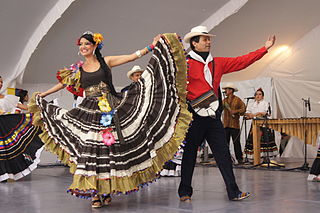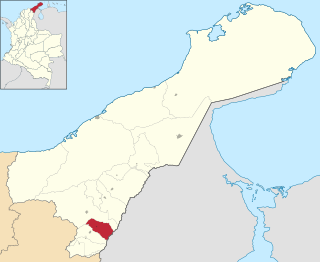
Colombia, officially the Republic of Colombia, is a country largely in the north of South America, with territories in North America. Colombia is bounded on the north by the Caribbean Sea, the northwest by Panama, the south by Ecuador and Peru, the east by Venezuela, the southeast by Brazil, and the west by the Pacific. It comprises 32 departments and the Capital District of Bogotá, the country's largest city. With an area of 1,141,748 square kilometers, Colombia is the fourth-largest country in South America, after Brazil, Argentina and Peru. It is also the 25th-largest country in the world, the fifth-largest country in Latin America, and the fourth-largest Spanish-speaking country.

Terrassa is a city in the east central region of Catalonia, in the province of Barcelona, comarca of Vallès Occidental, of which it is the cocapital along with Sabadell. The name "Terrassa" may well be a contraction/corruption of late Latin: 'terra ix ipsa' -> proto-aragonese 'terra-iš-sa' potentially conflated with 'terra-ès-sà' "safe-place/clean-place".

Many aspects of Colombian culture can be traced back to the early culture of Spain of the 16th century and its collision with Colombia's native civilizations. The Spanish brought Catholicism, the feudal encomienda system, and a caste system that favored European-born whites. After independence from Spain, the criollos struggled to establish a pluralistic political system, between conservative and liberal ideals. The conservatives supported the involvement of the Catholic Church in the state, while liberals favored the separation of these. The conservatives managed to outsource public education to the Catholic Church, and for many years, the church controlled the country's education system. Both parties engaged in multiple civil wars resulting in a slow development of the country and the isolation of regions until the end of the 19th century. Ethno-racial groups maintained their ancestral heritage culture: whites tried to keep themselves, despite the growing number of illegitimate children of mixed African or indigenous ancestry. These people were labeled with any number of descriptive names, derived from the casta system, such as mestizo, mulatto and moreno. Blacks and indigenous people of Colombia also mixed to form zambos, creating a new ethno-racial group in society. This mix also created a fusion of cultures. Carnivals for example became an opportunity for all classes and colors to congregate without prejudice. The introduction of the bill of rights of men and the abolishment of slavery (1851) eased the segregationist tensions between the races, but the dominance of the whites prevailed and prevails to some extent to this day.
Freedom of religion in Colombia is enforced by the State and well tolerated in the Colombian culture. The Republic of Colombia has an area of 439,735 square miles and its population is estimated at 46 million. Although the Government does not keep official statistics on religious affiliation, a 2001 poll commissioned by the country's leading newspaper, El Tiempo, indicated that the religious demography is as follows:

The Catholic Church in Colombia is the branch of the Roman Catholic Church in the South American nation of Colombia.

Colombian Americans, are Americans who trace their ancestry to Colombia. The word may refer to someone born in the U.S. of full or partial Colombian descent or to someone who has emigrated to the U.S. from Colombia. Colombian Americans are the seventh-largest Latin American group and the largest South American Hispanic group in the United States.

The Catholic Church in Spain is part of the Catholic Church under the spiritual leadership of the Pope in Rome, and the Spanish Episcopal Conference.

The Roman Catholic Archdiocese of Tegucigalpa is the only Metropolitan see in Honduras, whose ecclesiastical province covers the whole country.

Colombians are people identified with the country of Colombia. This connection may be residential, legal, historical or cultural. For most Colombians, several of these connections exist and are collectively the source of their being Colombian.

El Molino is a town and municipality located in the Colombian Department of La Guajira.

The Roman Catholic Archdiocese of Santo Domingo is a Latin Metropolitan Archdiocese in the Dominican Republic. The see was erected 8 August 1511 as the Diocese of Santo Domingo and elevated to archdiocese on 12 February 1546.
The National Administrative Department of Statistics (DANE) does not collect religious statistics, and accurate reports are difficult to obtain. However, based on various studies and a survey, about 90% of the population adheres to Christianity, the majority of which (70.9%) are Roman Catholic, while a significant minority (16.7%) adhere to Protestantism. Protestant Christians present in Colombia are Baptists, Lutherans, Mennonites, Nazarenes, Pentecostals and Seventh-day Adventists. The government generally is in support of religious freedom.

The Archdiocese of Bogotá is a particular church of the Roman Catholic Church in Colombia. It was established in 1562 as the Diocese of Santa Fe en Nueva Granada, elevated to an archdiocese two years later, and was given its current name in 1891. It serves nearly 3.8 million Catholics in Bogotá and parts of the Cundinamarca Department, and covers a total area of 4,109 km2. The current archbishop is Luis José Rueda Aparicio since 2020.

The contribution of travel and tourism to GDP was US$5,880.3bn in 2016. Tourism generated 556,135 jobs in 2016. Foreign tourist visits were predicted to have risen from 0.6 million in 2007 to 4 million in 2017. Responsible tourism became a peremptory need for Colombia because it minimizes negative social, economic and environmental impacts and makes positive contributions to the conservation of natural and cultural heritage.
Religion in Colombia is dominated by various forms of Christianity and is an expression of the different cultural heritages in the Colombian culture including the Spanish colonization, the Native Amerindian and the Afro-Colombian, among others.

The Roman Catholic Diocese of Barrancabermeja is a Latin suffragan diocese in the Ecclesiastical province of Bucaramanga.

The Roman Catholic Diocese of Villarrica del Espíritu Santo is a Latin Rite suffragan diocese in the Ecclesiastical province of the Metropolitan Archdiocese of Asunción, which cover all and only Paraguay.

This article is about the demographic features of the population of Colombia, including population density, ethnicity, education level, health of the populace, economic status, religious affiliations and other aspects of the population. It is the second-most populous country in South America after Brazil.
White Colombians are the Colombian descendants of European and Middle Eastern people. According to the 2005 Census 85% of Colombians do not identify with any ethnic group, thus being either White or Mestizo, which are not categorized separately. It is nevertheless estimated that 37% of the Colombian population can be categorized as white, forming the second largest racial group after Mestizo Colombians (49%).
William Mauricio Beltrán Cely – Colombian sociologist, professor from the Universidad Nacional de Colombia; the area of interest is a religious pluralization in Colombia and growth of protestantism.













